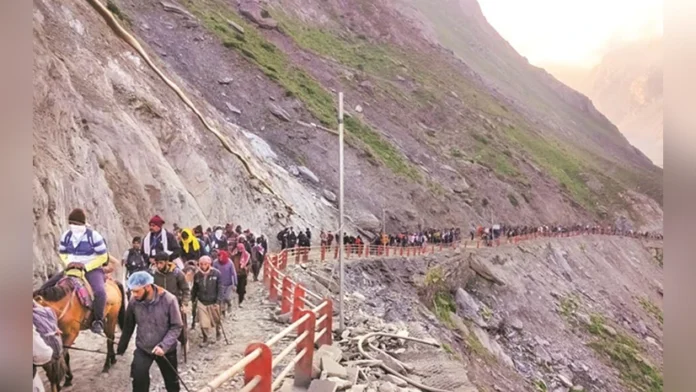The sacred Amarnath Yatra, an annual pilgrimage to the Amarnath cave shrine in Jammu and Kashmir, holds profound religious significance for Hindus across India and beyond. Typically spanning from early July to early August, trillions of devotees undertake treks on one of two routes—Pahalgam or Baltal—ascending to 3,888 meters to seek blessings from the naturally formed ice Shiva-lingam.
In 2025, the pilgrimage began on July 3 and was scheduled to conclude on August 9, coinciding with Shravan Purnima and Raksha Bandhan.
Backdrop to the Suspension
The 2025 Yatra was organized under heightened security, following a tragic terror attack in Pahalgam on April 22, which claimed the lives of tourists and a local pony-wallah. In response, authorities launched Operation Sindoor, deployed extra central security forces, and designated the Yatra routes as a strict No‑Fly Zone from July 1 to August 10, banning drones and balloons over the routes.
Sequence of Weather‑Induced Halts
Mid‑July Suspension
- July 17, 2025: After continuous heavy rainfall across Jammu & Kashmir, authorities suspended the pilgrimage from all three base camps—Jammu, Pahalgam, and Baltal ✳️.
- The layover was triggered by landslides, rockfalls (“shooting stones”), and treacherous track conditions.
- The Indian Army conducted a major rescue operation, evacuating 500 stranded pilgrims from landslide‑hit zones.
Resumption
- On July 18, the pilgrimage resumed after a day of suspension. A convoy of 7,908 pilgrims departed from Jammu toward Nunwan (Pahalgam) and Baltal camps. By then over 2.50 lakh yatris had already visited the cave shrine.
Late‑Month Suspension
- July 30–31: A second suspension occurred due to renewed heavy rains and flash floods—particularly severe in Ramban and Ganderbal districts.
- Local tragedies included the death of two government teachers in Ramban due to flash floods.
- The Yatra was halted for a second successive day from Jammu, with authorities citing pilgrim safety concerns.
- By that point nearly 3.93 lakh pilgrims had completed darshan so far.
Track Workforce and Suspension from August 3
While public attention has focused on the pilgrims, a critical operational element is the workforce responsible for maintaining and securing the trekking tracks: the Border Roads Organisation (BRO), associated rescue teams, local contractors, Assam Rifles, police and paramilitary support.
What Does “Track Workforce Suspension” Imply?
- Starting August 3, 2025, authorities reportedly ordered a suspension of track‑maintenance deployment, effectively halting repairs, clearing, and support operations along both Pahalgam and Baltal routes.
- This workforce includes road‑clearing crews, repair engineers, medical camp operators, rest‑area managers, and emergency rescue teams.
Reasons Behind the Suspension
- Extremely erratic monsoon: Continued rains beyond typical season had created frequent slips, washouts, and rockfalls, overwhelming track‑maintenance design.
- Operational fatigue: BRO and rescue teams had been operating non‑stop since mid‑July. Extended mission cycles raised safety concerns for personnel.
- Pilgrim throughput slowdown: By early August the number of daily pilgrims had dwindled, lowering immediate pressure on track readiness.
- Weather forecasts: Persistent rain was expected to continue through early August, making operations unsafe or counterproductive.
Impacts
- Resumption delays for remaining pilgrims: Pending workforce availability, if the tracks aren’t cleared or secured, remaining batches from Jammu or base camps may be postponed—a concern given that the pilgrimage officially ends August 9.
- Safety concerns: Without maintenance crews, already weakened or slippery sections could degrade further, posing risk to pilgrims on the final stretch of the trek.
- Psychological strain: Pilgrims already on-route or stranded at camps may face uncertainty, discomfort, or logistical challenges in shelters.
- Sequencing challenges: Unstable workforce deployment may disrupt the carefully paced convoys arranged from Bhagwati Nagar (Jammu).
Stakeholder Reactions
Shri Amarnath Shrine Board (SASB)
While specific statements regarding the August 3 workforce suspension haven’t been publicly released, the SASB typically emphasizes safety and infrastructure readiness. In past weather-induced halts, it has cooperated with BRO and state agencies to resume Yatra only once conditions improve.
Government and BRO
BRO generally frames such suspensions as short-lived tactical halts. Historically, after weather improves, they rapidly redeploy to restore connectivity within 24–36 hours, as seen during July’s land‑slip delays.
Pilgrims and Support Personnel
On-ground reports indicate disrupted movement and the need for clarity on new departure schedules. Many yatris depend on real-time updates via official channels, mobile alerts, and support hotlines.
Comparison with Past Precedents
2023 Suspension
In July 2023, heavy rains damaged the Jammu–Srinagar highway at Ramban, forcing a three‑day suspension. Over 15,000 pilgrims were stranded before the highway was repaired and the Yatra resumed.
1996 Tragedy
In August 1996, sudden blizzards and poor planning led to the death of over 250 pilgrims, highlighting the perils of monsoon trekking mismanagement.
2000–2001 Terror Attacks
Terrorist violence in 2000 and 2001 resulted in mass casualties along the pilgrimage route, shaping today’s stringent security and workforce protocols.
Timeline Overview
| Date | Event |
|---|---|
| July 3 | Amarnath Yatra begins for 2025 |
| July 17 | First weather‑induced nationwide suspension |
| July 18 | Resumption; 7,908 pilgrims depart |
| July 30–31 | Second suspension due to renewed heavy rain |
| Aug 1 | Traveling from Jammu suspended second consecutive day |
| Aug 3 | Track workforce officially suspended |
| Aug 9 | Official end of Yatra window |
What Lies Ahead
If the track workforce remains suspended beyond a day or two:
- Pilgrimage flow will stall, potentially leaving thousands mid-route or stranded at base camps.
- Completion of Yatra by August 9 may become impossible, forcing authorities to announce extensions or exceptions.
- Local economies—hoteliers, transporters, pony‑wallahs in Jammu and Kashmir—face losses if flow is disrupted.
However, if weather improves:
- BRO and rescue teams are expected to restore route integrity swiftly.
- Yatra may resume within 24–36 hours, as seen before.
- Remaining pilgrims might complete darshan before the window closes.
Analysis: Was the Suspension Justified?
Pro‑Safety Viewpoint:
- Prioritizing human life: Soldiers and rescue personnel also face risk amid landslides and unstable terrain.
- Previous incidents show that continuing under extreme conditions results in casualties.
Counter‑Critique:
- Some argue that more manpower or staging assistance (temporary helicopter airlifts) could have reduced disruption.
- Communication gaps have left many pilgrims anxious with little clarity on updated schedules.



